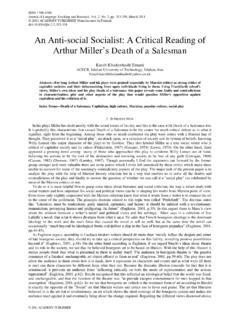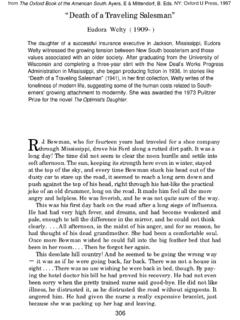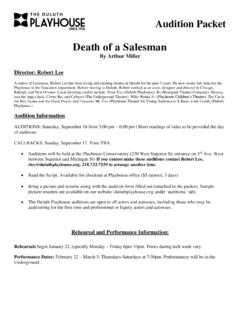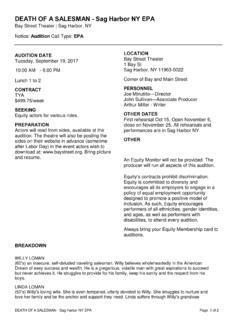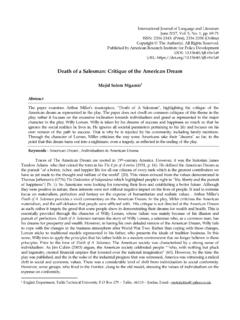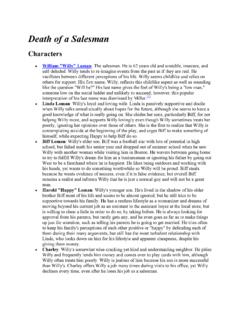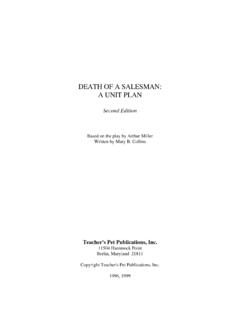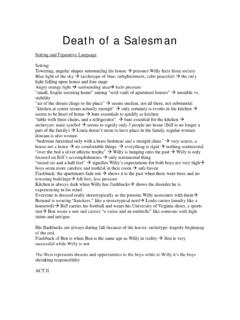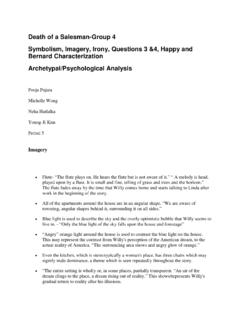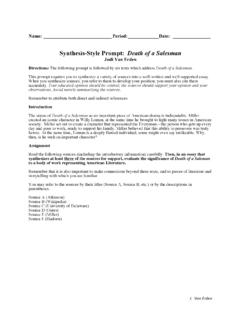Transcription of DEATH OF A SALESMAN STUDENT PACKET - …
1 NAME:_____DATE:_____ PERIOD:_____ ENOCHS JUNIOR CURRICULUM 2014 CCCS RL 2, 3, 4, 5, 6, 9 1 DEATH OF A SALESMAN STUDENT PACKET Check when done! Assignment Points possible Points earned 1 Quick Write & Communication Dynamics Activity 20 2 DEATH of a SALESMAN Essential Questions Group Assignment (Critical Response & Analysis) 16 3 Motifs/Themes & Symbolism (Critical Thinking & Analysis) 30 4 DEATH of a SALESMAN Study Guide Questions (Comprehension Questions) 32 5 Quotes to Know (Critical Thinking & Analysis) 28 6 Conflict in DEATH of a SALESMAN (Critical Thinking & Analysis) 26 7 Thematically Related Poetry SOAPSTONE & Literary Response & Analysis (Critical Thinking & Analysis) 40 TOTAL 192 NAME:_____DATE:_____ PERIOD:_____ ENOCHS JUNIOR CURRICULUM 2014 CCCS RL 2, 3, 4, 5, 6, 9 2 DEATH OF A SALESMAN by Arthur Miller I.
2 PRE-READING QUICKWRITE: Answer the following questions below be thorough. 1. How important is it to be well-liked in life? (5 pts.) 2. How has your past shaped the person you are today at this moment? How will it shape your future? (5 pts.) II. PRE-READING ACTIVITY: Communication Dynamics (10 pts.) A. List 5 qualities of good communication ( .listening without interrupting) 1. 2. 3. 4. 5. B. List 5 qualities that impair communication ( closed mindedness) 1. 2. 3. 4. 5. C. List 5 qualities of positive parent-child relationships 1. 2. 3. 4. 5. D. List 5 problems associated with keeping secrets in a family. 1. 2. 3. 4. 5. NAME:_____DATE:_____ PERIOD:_____ ENOCHS JUNIOR CURRICULUM 2014 CCCS RL 2, 3, 4, 5, 6, 9 3 STRUCTURE OF THE PLAY Two Acts and a Requiem. Act I opens in present day and Miller makes frequent use of flashbacks to illustrate how Willy s past experiences led to his current situation.
3 The flashback scenes provide essential information to help us understand the problems of the Loman family. Each act takes place on a different day. TERMS TO KNOW Catharsis: The purging of feelings of pity and fear that, according to Aristotle, occur in the audience of the tragic drama. The audience experience catharsis at the end of the play, following the catastrophe. Tragedy: A type of drama in which the characters experience reversals of fortune, usually for the worse. In tragedy, catastrophe and suffering awai many of the characters, especially the hero. Examples include Shakespeare s Othello, and Hamlet; Sophocles Antigone and Oedipus the King, and Arthur Miller s DEATH of a SALESMAN . Tragic flaw: A weakness or limitation of character, resulting in the fall of the tragic hero. Othello s jealousy and too trusting nature is one example. Tragic hero: A privileged, exalted character of high repute, who, by virtue of a tragic flaw, suffers a fall from glory into suffering.
4 Sophocles Oedipus is an example. Requiem: Originally a Mass celebrated for the repose of a soul at DEATH ; now, a funeral song or lament for the dead. III. DEATH OF A SALESMAN ESSENTIAL QUESTIONS FOR CLASS DISCUSSION Be ready to discuss the following questions based on ideas formulated in class. You will take notes as a group on these questions that will be collected for credit. 1. Can a common man experience a tragic fall? 2. How do people establish and maintain their identities? 3. What sacrifices are defensible to exert one s pride and dignity? 4. At what point does the need or the perceived right to assert one s self become unacceptable in society? 5. How do misunderstandings and faulty communication patterns generate separation and relationship dysfunction? 6. What character traits engender self- knowledge and insight? 7. To what extent are we responsible for the lives and happiness of others?
5 8. To what extent can we legitimately blame others for our unhappiness or problems? NAME:_____DATE:_____ PERIOD:_____ ENOCHS JUNIOR CURRICULUM 2014 CCCS RL 2, 3, 4, 5, 6, 9 4 IV. MOTIFS AND THEMES: A motif is a recurring image, word, phrase, object, character, or situation that acts as unifying idea and operates to develop theme or ideas in the work. Sometimes motifs recur so frequently that they enhance the meaning of the drama and rise to symbolic importance. Motifs link main ideas through as work. (2 pts. each) DIRECTIONS: Explain the significance of each of the motifs below? First one is completed as an model for the remaining motifs. 1. Vital to New England Willy s perception as a SALESMAN in New England is that he is needed and necessary, but the reality is that he s not good enough to get a job at the home office. 2. Well liked/personal attractiveness 3.
6 Theft and associated values (cheating) 4. Debts 5. Boxed in 6. Ben and The American Dream 7. Silk Stockings 8. Happy (isn t happy) 9. Father-Son Relationship 10. The Flute V. SYMBOLISM: Symbolism is the use of symbols (objects or things) that represent ideas and qualities different from their literal sense. DIRECTIONS: Write a statement and use a specific reference from the play to explain the meaning of the symbols listed below. (2 pts. each) 1. Seeds 2. Diamonds/Jungle 3. Stockings 4. The rubber hose 5. Alaska, Africa, American West 6. Tennis Racket NAME:_____DATE:_____ PERIOD:_____ ENOCHS JUNIOR CURRICULUM 2014 CCCS RL 2, 3, 4, 5, 6, 9 5 VI. COMPREHENSION QUESTION ABOUT THE PLAY DIRECTIONS: Answer all comprehension questions on a separate sheet of paper. Make sure you label your responses at the top and answer in complete sentences.
7 (2 pts. each) ACT I 1. Describe three specific incidents when Willy contradicts himself. What do these contradictions indicate about Willy s personality and character? 2. Cite 3 examples of what is probably considered bad advice Willy gave to his sons. 3. Cite 3 times Happy was ignored. How does Happy compensate for the treatment he receives? 4. Cite 3 times Biff drop hints about the problem between Willy and him. 5. Why did Biff come home? Where had he been? 6. List 3 times Biff stole something. 7. Describe a time when Willy was confused. What does this tell you about his mental state? 8. What does the flute music mean in the play? ACT II & REQUIEM 9. In what important way did Biff s life end after the Ebbet s Field game? 10. What does Biff realize about his life the day he goes to see Oliver? 11. Which brother do you have more respect for and why?
8 12. Willy is finally honest when he asks Bernard if he (Willy) did something wrong as a father. If you were Bernard, what would you tell Willy? 13. How is Willy s comment about Bernard arguing a case before the Supreme Court a commentary on Willy s life? 14. In what ways did Willy misunderstand Biff? Why does he keep calling Biff s actions spite ? What is Biff trying to tell his father on pages 132-133? 15. How does Willy s DEATH support the idea that Willy was never able to grasp the reality of his life and his family s situation? 16. What double meaning might be in Linda s final words at the end of the Requiem? NAME:_____DATE:_____ PERIOD:_____ ENOCHS JUNIOR CURRICULUM 2014 CCCS RL 2, 3, 4, 5, 6, 9 6 VII. QUOTATIONS TO KNOW DIRECTIONS: For each quote: 1. identify the context and 2. explain the relevance. Note that some of the quotations are presented in sets.
9 Treat them as one choice. Complete on separate sheet of paper. (28 pts) EXAMPLE: Biff: Because I know he s fake and he doesn t like anybody around who knows. CONTEXT: This quote reveals more about Biff and Willy s relationship. Biff doesn t like his father for some reason. SIGNIFICANCE: Biff thinks his father is phony and disingenuous and believes that his father doesn t want to be around people who can see through him. ACT I 1. Happy: See, Biff, everybody around me is so false that I m constantly lowering my standards. Biff: Hap, the trouble is we weren t brought up to grub for money. I don t know how to do it. 2. Biff: He s (Bernard) liked, but he s not well-liked. Willy: Be liked and you will never want. You take, me, for instance. I never had to wait in line for a buyer. 3. Willy; Ben! That man was a genius, that man was success man knew what he wanted and went out and got it!
10 Walked into a jungle, and comes out, the age of twenty-one, and he s rich! Ben: Why boys, when I was seventeen I walked into the jungle, and when I was twenty-one I walked out. And by god I was rich. 4. Ben: Father was a very great and a very wild- hearted man. Great inventor, Father. With one gadget he made more in a week than a man like you could make in a lifetime. 5. Linda: I don t say he s a great he s a human being, and a terrible thing is happening to him. Attention , attention must be finally paid to such a person. 6. Linda: He drives several hundred miles, and when he gets there no ones knows him, no one welcomes him. And what goes through a man s mind, driving several hundred miles without having earned a cent? Is this his reward- to turn around at the age of sixty-three and find his sons, who he loved better than his life, one a philandering 7.
